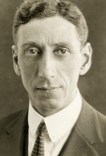 Irishman Charles B. Franklin was one of the most influential people in the formative years of American motorcycling.
Irishman Charles B. Franklin was one of the most influential people in the formative years of American motorcycling.
Franklin’s engineering prowess and design vision created the motorcycles that defined the enduring brand of Indian Motocycles, while his love of competition and foresight made an early and lasting impact on the competitive landscape of the sport.
Franklin was born in October 1880, in Dublin, Ireland. A well-rounded private education provided the foundation for his career as an electrical engineer, but soon he focused his time and resources on his passion: the world’s budding love affair with motorcycles.
That interest ignited the spark that led Franklin to become a racer and eventually work as an engineer for Hendee Manufacturing Co. in Springfield, Mass., which produced Indian motorcycles.
His early work at Indian focused on improving the existing Powerplus engine, which became the standard measure of American racing motorcycles.
Franklin’s greatest contributions were the bikes he created. These included his masterpiece, the Indian Scout, which was introduced in 1920 as a mid-size, 600cc machine. It was revolutionary in a time when most American models displaced 1,000cc or more. There later came a 750cc version, as well as the legendary 101 Scout in 1928, a model that many consider one of the greatest production motorcycles ever made.
Franklin, who also created another iconic model, the Chief, was one of the era’s foremost motorcycle designers. He not only made Indian motorcycles viable for the racecourse, but he also envisioned and produced production motorcycles that helped establish a brand identity that endures today.
In addition to his contributions to motorcycle design, Franklin was a standout among the first generation of motorcycle racers on the British Isles.
Franklin even excelled at what arguably remains the world’s most famous motorcycle race: the Isle of Man TT, an event that he helped conceive.
At the 1909 TT where Franklin finished fifth, Lee Evans, riding an Indian twin, crossed the line in second. If Franklin wasn’t aware of the capabilities of the red American motorcycle before, he was now.
Following an inspired effort in 1910 that was unfortunately hampered by tire troubles, Indian’s 1911 assault on the TT was the American company’s year. Franklin himself was a factory-supported rider on a team led by American star and future Hall of Famer Jacob DeRosier. Although DeRosier crashed and was ultimately disqualified, Indian riders Oliver Godfrey, Arthur Moorhouse and Franklin swept the podium.
Franklin competed for Indian in Ireland until he joined the company’s engineering department and moved to its headquarters, where he helped design the future of American motorcycling.
Franklin passed away in 1932 at the age of 52. His daughter, Phyllis, died in 2007 with no descendants.